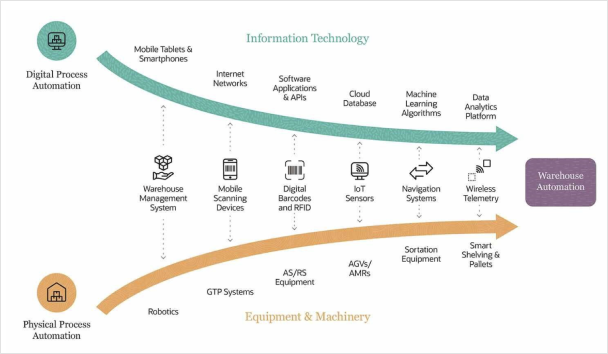Latest
The Complete Manual of Warehouse Automation – Types, Advantages, Best Practices

Introduction
The intralogistics & warehouse automation industry is currently experiencing rapid technological advancements. Thus, adopting end-to-end intralogistics solutions becomes a pressing priority.
Welcome to a sneak-peak into the basics of warehouse automation, its best practices and current trends.
What is Warehouse Automation?
In broad terms, it encompasses modern upgrades in a warehouse environment moving inventory in & out of a fulfillment center with minimal human intervention. It includes software, hardware, person & processes required to mechanize warehouse tasks thus boosting productivity, accuracy & safety. This not just involves labelling inventory items & capturing warehouse data but also automates storage and retrieval of parcels throughout the process.
Types of Warehouse Automation?
Broadly, there are 2 types of warehouse automation: digital automation and physical automation.
Physical Automation
Includes usage of high-end sophisticated robots like autonomous mobile robots (AMRs), automated guided vehicles (AGVs), and goods-to-person (GTP) technology.
Digital Automation
It includes the usage of statistics & software to reduce the labor-intensive processes. Soaring technologies such as AI, scanning devices, machine learning algorithms & other Industry 4.0 compliant solutions help us accomplish this task.
When to automate your Warehouse?
The peak season requires the fulfilment centres to work at full capacity. The rampant Ecommerce demand pushes the market players to work beyond their ideal targets and operate and maximum efficiency. This becomes very burdensome for the players. Hence, if your business experiences any of the below listed signs, then it’s time for you to automate you warehouse and achieve operational efficiency.
Snowballing Error Rates
Rising demand makes the manual warehouse operations full of errors. Thus, any damage/pilferage of parcels can lead to chargebacks and returns.
Overdue Delivery
In today’s era the customer expects their order delivery within 24 hours. The rising customer demand coupled with the responsibility of maintaining customer loyalty can further add as an operational encumbrance.
Slow Picking Methods
Manual process can lead to incorrect stacking of goods & slow picking processes can cause delay in shipments thus impacting the brand image of the company.
Inventory Management
Out of stock inventory can be a huge red flag. Hence, improper planning & inventory management can act as an impediment.
Channels to Automate Warehouse
In order to leverage the advantages of an automated warehouse, the following order fulfilment technologies can be implemented at the warehouse: –
Goods to Person
It is a method of order fulfilment that directly picks items and delivers it to respective stations, thus ensuring ergonomic efficiency. When properly applied, this system can double or triple the speed of warehouse picking and offer peak operator performance.
ASRS
Built on a computer-controlled system it increases the inventory storage density and automatically places, retrieves & stores the parcels with precision, accuracy & speed.
PPTL
It is a smart fulfilment & consolidation technology that provides high throughput & great flexibility to eliminate miss sorts & efficiently manage individual SKUs.
PPTL can be used for myriad range of applications like picking, sortation, kitting, consolidation, and assembly.
AGV & AMR
The intelligent fleet of AGV & AMR is a modular system which can be configured to a completely automated fleet for sorting robots to suit one’s requirements. It swiftly handles complex tasks & reduces the scope of errors. It further reduces the operational cost & downtime which ultimately increases the profitability.
Sortation System
These systems accomplish key objectives such as labour reduction & dispatch accuracy, thus providing compact footprint that allows for optimizing warehouse space.
Benefits of Warehouse Automation
Research suggests, businesses viewed warehouse automation facilities as a financial distress for a long time. But with due course of time, a basic judgement has evolved into a solid strategy that not only contributes positively to their bottom-line, but also helps them reap economies of scale thus empowering them with a competitive lead.
Some of these advantages include: –
Minimalized Cost – A central warehouse reduces the cost of owning & operating multiple warehouses. Reduced labour charge & floor space further act as an added gain.
Fewer Personnel – A manually operated warehouse is likely to conduct iterative task every now and then. However, an automated warehouse ensures complete efficiency by automating the back-breaking chores & thus providing the personnel a window to focus improving business performance.
Improved Customer Service – Automating the warehouse allows businesses to shift their focus to high yielding areas and thus improving their customer service by providing them the latest technology and best-in-class equipment’s.
Increasing Speed – An automated warehouse optimizes routes and maximizes productivity during the product retrieval process. It speeds up order fulfilment when warehouses and as a result, these companies function on seemingly shorter commissioning time.
Establishes Floor Space & Air Rights – Automated warehouse maximizes space by utilizing robots and other AGV’s that complete product retrieval and storage tasks and thus help establishing floor space and make use of vertical space to capture air rights.
Enhanced safety – Reduced human footprints & lowered parcel traffic enhance the overall safety in the warehouse. This further reduces product damage/ pilferage.

To provide operational excellence effortlessness, Armstrong Dematic leads the way towards innovative intralogistics and warehouse automation solutions.
Follow
Quick Links
Contact
© 2024 Armstrong Dematic. All Rights Reserved.
